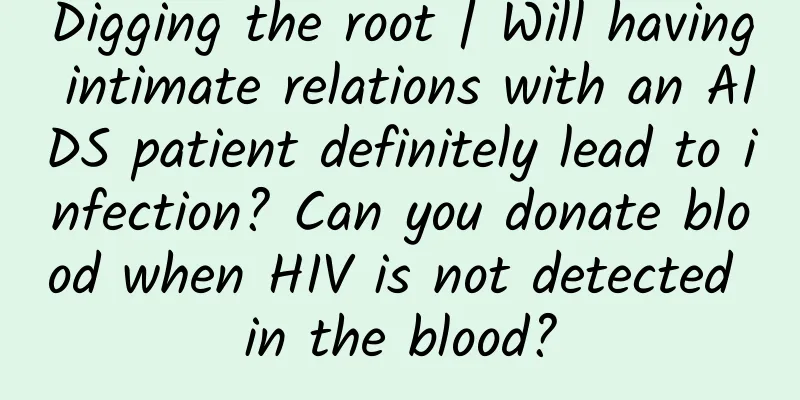Digging the root | Will having intimate relations with an AIDS patient definitely lead to infection? Can you donate blood when HIV is not detected in the blood?

|
gossip The pathogen of AIDS is HIV (human immunodeficiency virus), which is transmitted in three main ways: mother-to-child transmission, sexual transmission, and blood transmission. So will AIDS patients definitely transmit HIV to their partners? There are rumors that the viral load in well-controlled AIDS patients is very low. If the presence of HIV cannot be detected in their blood, these AIDS patients will not transmit AIDS to their partners through sexual transmission. Therefore, many AIDS patients believe that when the amount of virus in their bodies is low enough, so low that it cannot be detected in blood tests, they will no longer spread AIDS and can even start donating blood actively. Copyrighted stock images, no reproduction is authorized So, when HIV is not detected in the blood, is it true that AIDS can no longer be transmitted through sex? Can HIV patients who are not sexually transmitted really donate blood? Is there a chance of contracting AIDS during blood transfusion? How is AIDS tested when donating blood? analyze When donating blood now, nucleic acid testing is mainly used to check whether the donor has HIV. The viral load required for blood transmission and sexual transmission of AIDS is different. Although those AIDS patients with extremely low viral loads are unlikely to infect their partners through sexual transmission, their donated blood still has the risk of spreading AIDS. HIV-infected individuals with undetectable viral load Will not transmit HIV to their partner Many people have always been concerned about whether blood transfusion will lead to the spread of HIV virus. This concern is not groundless. In the 1990s, there were many cases of HIV infection caused by blood transfusion and blood donation in our country. Until the beginning of this century, with the country's rectification of blood collection standards and the popularization and application of various testing technologies, the transmission of HIV through blood transfusion has been basically blocked in the past decade. The report of the National Health Commission also shows that my country's AIDS prevention and control policies are becoming increasingly perfect, and blood transfusion transmission has been basically blocked. The clinical blood use HIV nucleic acid testing is fully implemented, and the number of cases of transmission through blood transfusion and the use of blood products is close to zero. This is a very remarkable achievement. In recent years, there has been a well-known HIV awareness campaign on a global and international scale, namely U=U: "Undetectable = Untransmittable". The U=U campaign was launched in 2016 and is based on the statement that: “People living with HIV who have an undetectable viral load cannot transmit HIV to their partners.” The purpose is to reduce and eliminate discrimination and fear against AIDS patients . Many organizations including the International AIDS Society (IAS) and the Joint United Nations Programme on AIDS (UNAIDS) have responded to this statement. The basis behind this statement is also based on a number of research results, such as the latest research published in The Lancet. The researchers searched PubMed, MEDLINE, Cochrane Central Register of Controlled Trials, Embase, Conference Proceedings Citation Index-Science, and WHO Global Index Medicus databases from 2010 to 2022, and finally included 8 studies, including 4 cohort studies, 3 randomized controlled trials, and 1 large international cross-sectional study. Overall, this systematic review found that when the viral load of HIV-infected people is less than 1000 copies/ml, the risk of sexual transmission of HIV is almost zero. Specifically: When the viral load of an HIV-infected person is less than 200 copies/ml, the risk of sexual transmission of HIV is zero. When the viral load of HIV-infected people is lower than 600 copies/ml, no clear evidence of sexual transmission of HIV is found. When the viral load of an HIV-infected person is between 600 and 1000 copies/ml, the possibility of sexual transmission of HIV is extremely low. The Lancet also published an editorial at the same time, arguing that this study provided strong data support for the concept that "undetectable = not spreadable." How do we test for HIV? What does the HIV testing window period mean? However, the campaign, which was originally intended to eliminate discrimination against AIDS, has now created new problems for the existing blood donation and transfusion system. To put it simply, HIV patients who are receiving antiretroviral therapy (ART) take their medication properly, and their viral load may be suppressed to "below the detection limit" (generally below 1000 copies/ml), which means that the presence of the virus cannot be detected using standard nucleic acid detection methods. This state is usually called "no viral load". If these people participate in blood donation, because their viral load is below the detection limit, they cannot be detected, but they will also pose a risk of HIV infection through blood transfusion. To understand this issue, we need to interpret it from two aspects. The first thing is to understand the current blood donation mechanism. In the last century, the global blood donation mechanism was very extensive at the beginning, and there was no testing and screening of blood donors or blood, which resulted in a lot of blood-borne diseases, including AIDS, hepatitis B and hepatitis C. Later, in response to this problem, we added a testing mechanism for various viruses, but this test cannot completely detect all problems 100%. For example, there is a well-known problem in HIV virus testing - the window period . Copyrighted stock images, no reproduction is authorized What is the HIV testing window period for blood donation? Generally, it refers to the time period from when a person is infected with HIV to when the infection can be detected by standard tests. During this window period, an infected person's blood may not show a positive result, but their blood may actually be contaminated with the virus and could potentially be spread to others. So the key point here is how long it takes for HIV patients to be detected after being infected, which is directly related to the technology used. For example, the earliest detection methods for HIV virus in our blood station were virus antibody detection and antigen/antibody detection. Viral antibody testing only detects antibodies to HIV, not viral antigens. Since it takes some time for the body to produce enough antibodies to be detected after infection, the window period is relatively long, usually 3-12 weeks. Later, a more sensitive antigen/antibody combination test was used, which can detect both HIV antigens (especially p24 antigen) and antibodies produced in the body against HIV. The window period is usually 2-6 weeks. However, it can be seen that the window period of these two detection methods is relatively long, and there may be more missed cases, which is indeed the case. The AIDS Institute of the First Affiliated Hospital of China Medical University once conducted a study. The institute's staff tested 98 new cases of acute HIV infection and found that 20 of the infected people were negative in antibody and antigen/antibody tests, but positive in nucleic acid tests. From this study, we can see that nucleic acid testing is a more sensitive method. Nucleic acid testing directly detects HIV RNA. Its advantage is that the virus can be detected within a short period of time after infection, usually within a window period of 1-4 weeks. However, nucleic acid testing is expensive, so it was not widely promoted in the early stage. In 2015, my country basically achieved full coverage of nucleic acid testing in blood stations, shortening the window period for AIDS and reducing the risk of contracting diseases through blood transfusion. Later, with the continuous advancement of scientific research and technology, we reduced the HIV detection window period to 10-11 days. This is already the most advanced level in the world, and it is also one of the core reasons why my country has close to zero reports of cases of transmission through blood transfusion and use of blood products. However, it should be noted that even with the most advanced nucleic acid testing technology, there is still a window period, which means that there is still a risk of infection. This is one of the reasons why a risk consent form is still signed before blood transfusion. Why can't the virus be detected? Are AIDS patients still not allowed to donate blood? Now that we have finished talking about this detection window period, combined with the U=U movement mentioned earlier, have you discovered any problems? Among HIV-infected people who are receiving antiretroviral treatment, if the control effect is good, the virus content in their blood is very low and below the lower limit of detection, so there is a saying that it is undetectable. If these people donate blood, it is not a problem of window period, but it is definitely undetectable. So according to the saying “undetectable = untransmittable”, is their donated blood safe and usable? This is a misunderstanding of the core of the statement that undetectable = untransmittable. As mentioned earlier, the core of this statement is: "HIV-infected people with undetectable viral loads will not transmit HIV to their partners." Note that the emphasis here is on sexual transmission, not blood transmission. The HIV virus can be transmitted through three channels: blood transmission, mother-to-child transmission, and sexual transmission, but not being transmitted through sex and not being transmitted through blood are not the same concept. The risk of HIV virus being transmitted through different channels is not the same. For example, the data from the US Centers for Disease Control and Prevention are as follows. It can be seen that for every 10,000 exposure risks, the proportion of infection transmitted through blood transfusion is as high as 92.5%, while the risk of sexual transmission is only 0.04%-1.38%, a difference of several orders of magnitude. Why is there such a big difference? This is related to the infection mechanism of HIV transmission. We know that after HIV enters the human body, it infects CD4+T cells, which mainly exist in the blood. Blood transfusion will directly give HIV the opportunity to infect CD4+T cells. As for other modes of transmission, such as sexual intercourse, the mucous membrane must be damaged and bleeding must occur before the HIV virus has a chance to come into contact with the CD4+T cells in the blood and cause infection. This can also explain why anal sex is much more likely to spread HIV than other sexual behaviors, because the anal mucosal tissue is relatively thin and more easily damaged, making it easier for the HIV virus to come into contact with the CD4+T cells in the blood. From this we also observed a phenomenon that the viral load required for HIV transmission through blood and HIV transmission through body fluids is very different. As we mentioned earlier, the Lancet paper shows that when the viral load of HIV-infected people is lower than 1000 copies/ml, the risk of sexual transmission of HIV is almost zero. However, many studies have shown that the viral load transmitted through blood is much lower than this value . For example, the United States conducted a retrospective analysis of HIV transfusion-transmitted cases from 1999 to 2009 and found that the viral load in blood donors who caused transfusion-transmitted HIV infection was 50 to 250 copies/ml. According to mathematical models, the probability of HIV infection is 50% when 830 copies of HIV RNA are transfused. Based on this analysis, if 5 ml of blood with an HIV load of 199 copies/ml is transfused, HIV transmission may occur. You should know that it is impossible for us to transfuse only 5 ml of blood at a time. Generally, when blood transfusion is needed clinically, the amount of blood transfusion is measured in hundreds of ml. A study in South Africa showed that blood with a viral load as low as 12.7 copies/ml only required an average of 22.9 ml of transfusion to transmit HIV. 12.7 copies/ml is far below the detection limit of nucleic acid testing, which means it can be understood as undetectable, but these blood samples can still transmit HIV. In the same study, researchers found that HIV screening among blood donors showed that the proportion of HIV patients among blood donors increased from 0.27% 10 years ago to 2.43%, which is very worrying. Part of the reason is that many blood donors use drugs to control their HIV virus below the nucleic acid detection level, and these people join the blood donation ranks after thinking that their HIV virus is undetectable. The researchers called them HIV elite controllers (EC). Because of their blood donation behavior, the risk of HIV infection from blood transfusion, which had been reduced with great difficulty, was raised again. This problem is not limited to South Africa. All countries, including our country, are facing this risk. One of the correction methods currently being promoted is to carry out further popular science publicity to correct this misconception. in conclusion HIV-infected people with undetectable viral loads will not transmit AIDS to their partners through sexual transmission, but they still cannot donate blood. In fact, the amount of virus required for sexual transmission and blood transmission is completely different. AIDS can be transmitted through blood transfusions with only a very low load of the virus in the blood. Author: Lengzhe popular science author Reviewer: Lu Min, Associate Chief Physician, Institute of Hematology, Chinese Academy of Medical Sciences and Peking Union Medical College References: 1. The risk of sexual transmission of HIV in individuals with low-level HIV viraemia: a systematic review Broyles, Laura N et al. The Lancet, Volume 402, Issue 10400, 464 – 471 2.Marshall, DA, Kleinman, SH, Wong, JB, AuBuchon, JP, Grima, DT, Kulin, NA and Weinstein, MC (2004), Cost-effectiveness of nucleic acid test screening of volunteer blood donations for hepatitis B, hepatitis C and human immunodeficiency virus in the United States. Vox Sanguinis, 86: 28-40. https://doi.org/10.1111/j.0042-9007.2004.00379.x 3. Kleinman SH, Lelie N, Busch MP. Infectivity of human immunodeficiency virus-1, hepatitis C virus, and hepatitis B virus and risk of transmission by transfusion. Transfusion. 2009 Nov;49(11):2454-89. doi: 10.1111/j.1537-2995.2009.02322.x. Epub 2009 Jul 21. PMID: 19682345. 4. Vermeulen M, Lelie N, Coleman C, Sykes W, Jacobs G, Swanevelder R, Busch M, van Zyl G, Grebe E, Welte A, Reddy R. Assessment of HIV transfusion transmission risk in South Africa: a 10-year analysis following implementation of individual donation nucleic acid amplification technology testing and donor demographics eligibility changes. Transfusion. 2019 Jan;59(1):267-276. doi: 10.1111/trf.14959. Epub 2018 Sep 28. PMID: 30265757; PMCID: PMC10419327. 5.https://www.cdc.gov/hiv/risk/estimates/riskbehaviors.html 6.Wendy Sykes and others, Discovery of False Elite Controllers: HIV Antibody-Positive RNA-Negative Blood Donors Found To Be on Antiretroviral Therapy, The Journal of Infectious Diseases, Volume 220, Issue 4, 15 August 2019, Pages 643–647, https://doi.org/10.1093/infdis/jiz145 The article is produced by "Science Refutes Facts" (ID: Science_Facts). Please indicate the source when reprinting. The cover image and images within this article are from the copyright gallery. Reprinting and quoting them may lead to copyright disputes. |
<<: Are stalagmites stones or bamboo shoots? They are the "perennial climate meters" in caves!
>>: Will drinking water with scale for a long time cause kidney stones? The answer is unexpected!
Recommend
The Doubao big model empowers the automotive industry and its circle of friends expands rapidly. How does it do it?
On August 21, the 2024 Volcano Engine AI Innovati...
What are the best attributions for app promotion at present?
The App has been developed, the advertising has b...
Liu Yiwei's "21 Ways to Get Commissions" plans commission designs suitable for the company's stage of development
Liu Yiwei's "21 Ways to Get Commissions&...
Is it because of lack of vitamin D that you are not getting enough sleep even if you sleep 12 hours a day? You will know after reading this!
Recently, a netizen posted that he "always d...
Providing offline support for mobile apps
Offline support for mobile applications can be un...
E Source: Research shows that battery costs will soar 22% by 2026, and electric car prices may increase by $3,000
According to foreign media reports, a new report ...
The Nine Swords of User Growth Strategy
Product " user growth " is the most tro...
Do you have unbearable stomach pain? Be careful! It may be...
I haven't had a bowel movement or passed gas ...
Activity operation channels and promotion methods!
After organizing several popular events recently,...
When the heart stops beating, how to give first aid? How can sports enthusiasts protect their hearts?
"The world is just an hourglass of memories,...
Soul-searching question after the Chinese New Year: Have I gained weight again? Insulin says I am not to blame
The Spring Festival holiday is over, have you gai...
It is best for brands not to do private domain
At present, the industry generally defines privat...
Three major trends in new media operations in 2017
On November 16, 2017, Penguin Think Tank and Tenc...
Flurry: Mobile gamers spend less time playing but more money
[[147285]] Flurry, a mobile application data anal...









